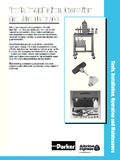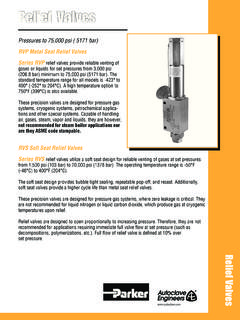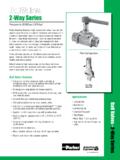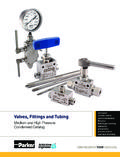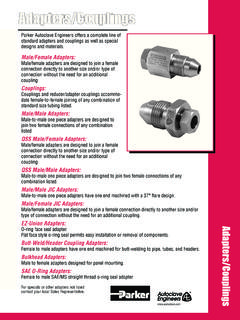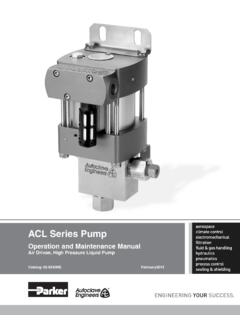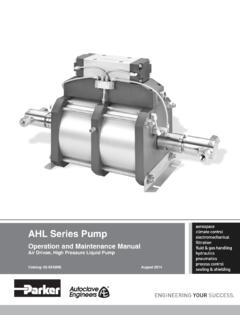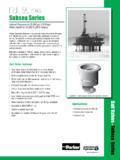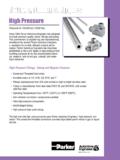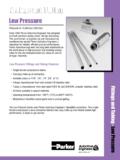Transcription of Technical Information - Autoclave
1 1 All general terms and conditions of sale, including limitations of our liability, apply to all products and services Information presented in this section is intended to assist designers in the proper selection of Parker Autoclave Engi-neers valves, fittings and tubing for fluid handling systems. This Technical data does not represent product specifications but rather guidelines for direction in the proper application of the referenced equipment. These guidelines are general in nature because of the many process severe service applications, selection of the appropriate valves, fittings and tubing is essential in order to optimize the service life of these products. Parker Autoclave Engineers Technical staff is available to assist in the interpretation of this InformationTechnical general terms and conditions of sale, including limitations of our liability, apply to all products and services Information - General InformationTechnical and Application InformationMaterials:Widely varying conditions frequently require that valves, fittings and tubing be constructed of materials other than con-ventional stainless steel.
2 Since many variables affect the corro-sion resistance of metallic materials, it is Parker Autoclave Engineers policy not to recommend materials based on corrosion resistance for specific fluid applications. We can, however, suggest materials based on mechanical strength and also indicate materials generally used in a specific application. Other materials not listed in this section are also :Included in this section are the standard pressure ratings for several common materials for valves and fittings as well as tubing. Parker Autoclave Engineers stocks a select quantity of special material tubing for immediate :Also contained in this section are pressure reduction factors at various temperatures for several materials. To obtain the maximum pressure rating at an elevated temperature, multiply the maximum pressure rating of the item at room temperature by the elevated temperature factor (% of RT).
3 High and low temperatures or high heat up and/or cool down rates can affect the capability of a metal-to-metal seal. When selecting a valve series, consideration should not only be given to static pressure rating, but also static and dynamic temperature conditions. Generally, the smaller the seal diam-eter of a metal-to-metal seal, the more reliable the seal will or Liquid Service:Light gases such as hydrogen and helium are more difficult to seal than liquids. When selecting a valve series, consideration should be given to the fluid application and not just pressure and temperature requirements. The higher the rating of the valve or fitting, the less the likelihood of weepage problems with light gases. Tubing selections should also consider the service requirements, since thicker wall, smaller outside diameter tube sizes will produce a more reliable connection seal.
4 Handling of fittings and tubing during installation will make a difference in sealability of light gases as well as liquids. Do not handle the tube or fitting in such a way as to damage the sealing surfaces. If it is process tolerable, a small amount of lubrication (or even process fluid) on the seal area during installation will help the sealing process. Refer to the Tools, Installation, Operation and Maintenance section for further stem packing Materials:The considerations listed thus far should be applied when selecting a suitable valve stem packing material (PTFE, PTFE glass or Graphite yarn). Where possible, PTFE packing is the most reliable, low maintenance, packing choice; PTFE/glass is the second. While graphite yarn packing is a reliable pack-ing material for the majority of extremely high temperature applications, some gases may permeate more readily through graphite yarn packing than through the PTFE packing in a valve with an extended stuffing box.
5 The packing material must be kept below the maximum permitted temperature listed on page 5. Valve stem Seating:Abrasive flow or high cycle service will require more frequent maintenance. Special materials and the proper valve series selection may extend service life. For example, if flow is not critical, a 30VM valve with an N-Dura stem will require less maintenance than an SW series valve used in a low pressure, high cycle, abrasive flow application. Although all application parameters cannot be considered in this section, the user can generally expect several thousand cycles in a liquid application and several hundred cycles for gas service. The packing gland may require adjustment, however, to achieve these Cycling:In medium and high pressure applications, static as well as dynamic (cyclic) pressure must be considered when selecting an appropriate valve series.
6 If fatigue life is a concern, Parker Autoclave Engineers can supply tubing which has been auto-frettaged for improved fatigue resistance. For internally pres-surized tubing, autofrettaging is a method by which the inner wall of the tube is precompressed to reduce the tube operating bore stresses. By applying sufficient internal pressure, greater than the maximum working pressure of the tube, the inner wall is plastically deformed by a controlled amount. The remain-ing outer portion of the wall acts elastically, and when the pressure is released, a positive compressive load at the bore will exist. As mentioned previously, the result is reduced bore stress and increased fatigue life. In addition to the autofrettag-ing method to increase cycle life, Parker Autoclave Engineers offers HP-HC (high-pressure high cycle) tubing, rated to 100,000 psi (6895 bar).
7 This tubing can be substituted for our standard 60,000 psi (4137 bar) tubing providing longer life at 60,000 psi (4137 bar) Service:The high, medium and low pressure series of Parker Autoclave Engineers standard valves, fittings and tubing can be used in light vacuum services to 10-2 torr. For high vacuums to 10-5 or 10-6 torr, Parker Autoclave Engineers high pressure series is recommended. Extreme care and proper seal lubrication is re-quired (as mentioned in the Gas or Liquid Service paragraph) to achieve these degrees of vacuum. The pump type and size will determine the final vacuum general terms and conditions of sale, including limitations of our liability, apply to all products and services Information - Coned & Threaded ConnectionsParker Autoclave Engineers Medium & High Pressure Coned and Threaded Connections Parker Autoclave Engineers Medium Pressure Coned and Threaded ConnectionsFeatures: Pressures to 20,000 psi (1379 bar) Uncompromised reliability under rigorous thermal and pressure cycling.
8 Design is a more compact version of the original Parker Autoclave Engineers High Pressure connections. Well suited to installations which require repeated assembly and disassembly with consistent reliability. Available in tube outside diameter sizes from 1/4 ( mm) through 1-1/2 ( mm) and bore sizes from .109 ( mm) to .938 ( mm).Note: 1" 43,000 psi (2965 bar) utilizes the medium pressure coned and threaded Autoclave Engineers High Pressure Coned and Threaded ConnectionsFeatures: Pressures to 60,000 psi (4137 bar) Increased pressure handling capabilities Uncompromised reliability under rigorous thermal and pressure cycling Well suited to installations which require repeated assembly and disassembly with consistent reliability. Available in tube outside diameter sizes of 1/4 ( ), 3/8 ( ) and 9/16 ( ) and bore sizes of.
9 083( ), .125 ( ), .188 ( ) and .250 ( ).Valve or FittingBodyCollarGlandCold-workedTubingP ositive Backup SupportLine-contactSealingValve or FittingBodyCollarGlandCold-workedTubingP ositive Backup SupportLine-contactSealingDifferences in angles exaggerated for in angles exaggerated for general terms and conditions of sale, including limitations of our liability, apply to all products and services Information - Coned and Threaded ConnectionsDesign Considerations - Why Coning and threading?High-pressure designs require a superior joining technique for valves, fitting and tubing. Conventional joining methods fall short of the reliability needed for pressures above 10,000 - 15,000 psi (690-1034 bar) and tube sizes above 1/4 outside diameter. Dissimilar angles between the body and the tube cone provide line contact sealing along the perimeter of a contact circle.
10 The sealing contact area is therefore, maintained at its practical minimum for the given tube size and a reliable seal is produced due to high sealing stresses that occur at low sealing loads. When process tolerable, a small amount of lubricant (or even process fluid) on the seal area will help improve the reliability of the metal to metal seals, especially when light molecule gases are to be sealed. The metal to metal seal also eliminates the need for elastomers in the backup support occurs with the collar threaded (left-handed) directly onto the tubing to form a positive integral retaining surface. This allows for a consistent connection make up that is required at higher pressures and temperatures. When the gland nut is threaded into the connection, the tubing is locked securely in place and the possibility for the ejection of the tubing from a properly assembled and used connection is extremely :Since the glands and threaded collars can be removed from the tubing, properly lubricated Parker Autoclave Engineers Medium-Pressure and High-Pressure connections can be dis-assembled and reassembled repeatedly without loss of relabil-ity.
